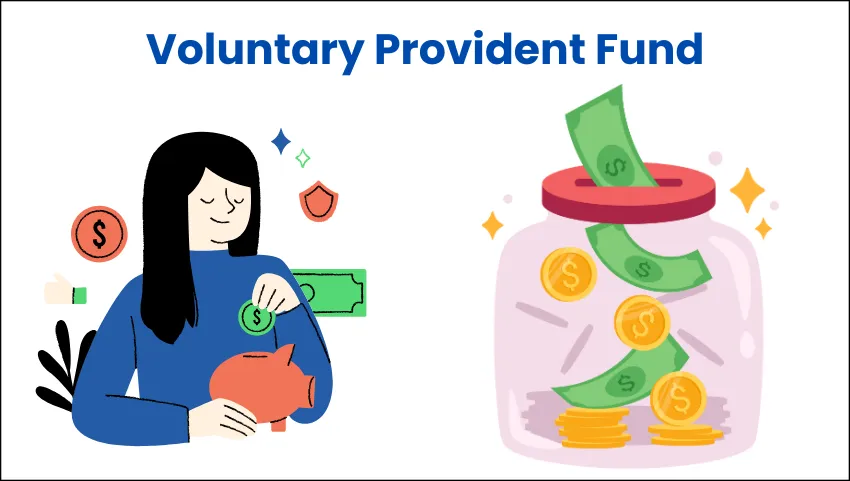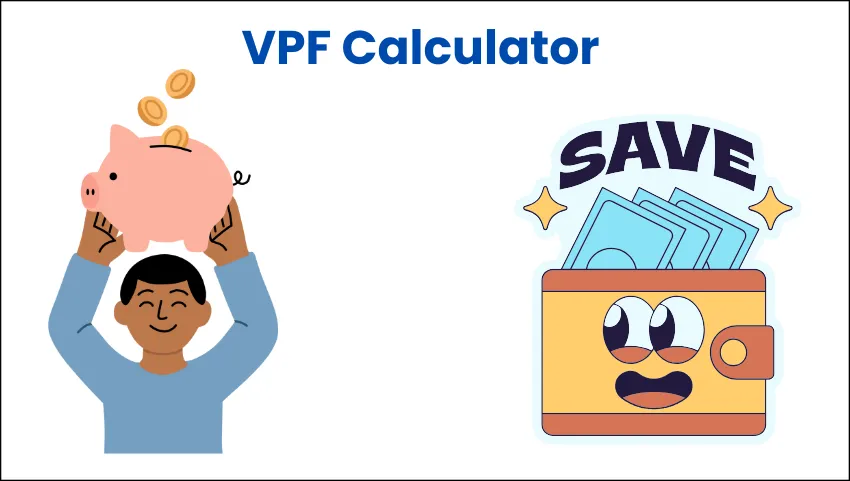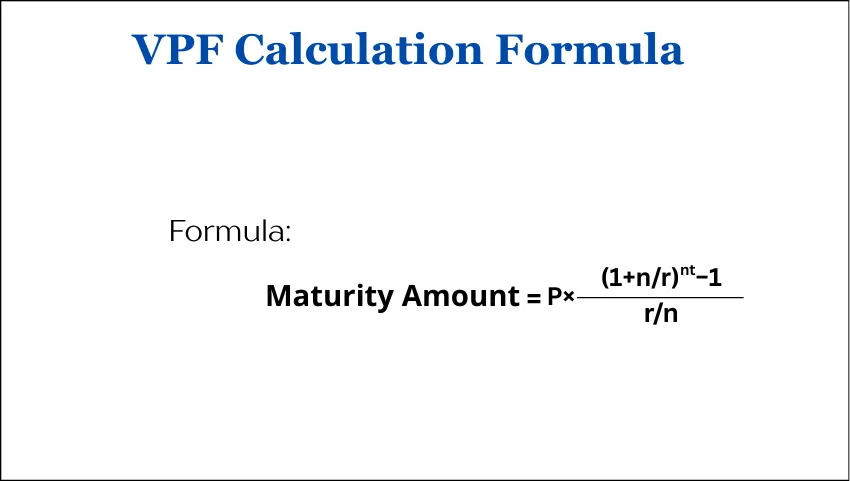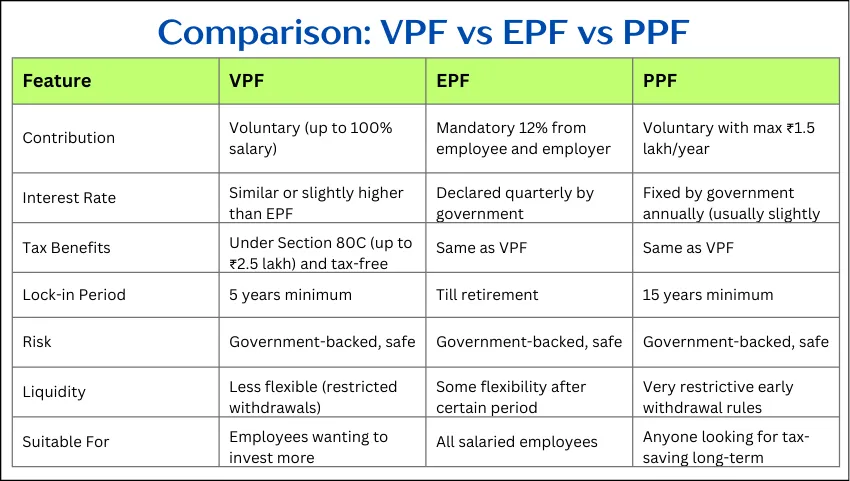VPF Calculator
Calculate your Voluntary Provident Fund maturity amount with accurate projections
Investment Details
Calculation Results
About VPF (Voluntary Provident Fund)
- VPF allows employees to contribute more than the mandatory 12% to their PF account
- Current VPF interest rate for FY 2024-25 is 8.25% per annum
- Maximum contribution limit is 100% of basic salary + DA, up to ₹2.5 lakh per year
- VPF contributions are eligible for tax deduction under Section 80C
- Interest earned is tax-free (if interest rate is below 9.5% per annum)
The Voluntary Provident Fund (VPF) Calculator is a handy online tool designed to help salaried employees estimate the total amount they will accumulate by contributing extra money voluntarily over their mandatory Provident Fund (PF) contributions. This tool makes it easier for employees to plan their retirement savings effectively and understand how their additional contributions will grow over time.
Understanding Voluntary Provident Fund (VPF)
VPF is a government-backed retirement savings scheme available to salaried employees who are already contributing to the Employee Provident Fund (EPF). Unlike EPF, where both employer and employee contribute a fixed percentage of the salary (usually 12%), VPF contributions are optional and made solely by the employee.

Key Features of VPF:
- Voluntary Contribution: Employees can contribute any amount up to 100% of their basic salary and dearness allowance (DA) beyond the mandatory 12% PF contribution.
- Government-Backed: Like EPF, VPF contributions are invested securely and earn guaranteed interest rates declared quarterly by the government.
- Tax Benefits: VPF enjoys tax exemption under Section 80C of the Income Tax Act, meaning contributions up to ₹2.5 lakh per financial year are eligible for tax deductions. The interest earned and maturity amount are also tax-free.
- Long-Term Savings: Ideal for building a bigger retirement corpus and ensuring financial security after retirement.
- Interest Rate: Typically higher than many fixed deposit schemes and subject to change every quarter, around 8% to 8.5% annually as of recent years.
Why Use a VPF Calculator?
A VPF calculator simplifies financial planning for retirement savings by providing the following benefits:

- Estimate Maturity Amount: Find out how much your voluntary contributions will grow after a specific duration.
- Plan Contributions: Decide how much extra you can comfortably contribute without straining your regular expenses.
- Compare Scenarios: Experiment with different contribution amounts or durations to see their impact on your retirement corpus.
- Visualize Returns: Understand how compounding interest boosts your savings over time.
Thus, the calculator acts as a financial planning aid, helping users make informed decisions about voluntary savings.
How Does the VPF Calculator Work?
The VPF calculator uses three main inputs to calculate the final maturity amount:
- Monthly Contribution (P): The additional amount the employee voluntarily contributes every month beyond the mandatory PF.
- Interest Rate (r): The annual interest rate declared by the government for the PF scheme. It’s usually compounded monthly.
- Investment Duration (t): How long the employee plans to keep contributing to VPF, measured in years.
The Calculation Formula

The compound interest formula used in VPF calculation is: Maturity Amount=P×nr(1+nr)nt−1
Where:
- PPP = Monthly contribution
- rrr = Annual interest rate (in decimal form, e.g., 8.1% = 0.081)
- nnn = Number of times interest is compounded per year (typically 12 for monthly)
- ttt = Number of years of contribution
This formula calculates the future value of a series of monthly investments compounded monthly, which builds a larger corpus over time.
Step-by-Step Guide to Using a VPF Calculator
Using a VPF calculator is simple and requires only a few inputs. Here’s how to use it effectively:
Step 1: Gather Details
- Monthly voluntary contribution amount you plan to invest.
- Current VPF interest rate (check official updates; commonly about 8-8.5% annually).
- Number of years you plan to keep contributing.
Step 2: Enter Details into the Calculator
Input your monthly amount, interest rate, and duration in the respective fields of the online calculator.
Step 3: Calculate and Review Results
The calculator will display the total maturity amount at the end of your investment period, showing both your contributions and the interest earned.
Step 4: Experiment with Options
Try different contribution amounts or durations to see how the maturity amount changes. This can help you choose the best saving plan for your retirement goals.
Example of VPF Calculation
Suppose Mr. Sharma decides to contribute ₹20,000 monthly to his VPF, the interest rate is 8.1% per annum compounded monthly, and he plans to invest for 15 years.
Using the formula:
- P=₹20,000P = ₹20,000P=₹20,000
- r=0.081r = 0.081r=0.081
- n=12n = 12n=12
- t=15t = 15t=15
The maturity amount is calculated as: 20,000×(1+0.08112)12×15−10.08112=₹53,48,471
This means after 15 years of consistent ₹20,000 monthly contributions, Mr. Sharma will have approximately ₹53.48 lakhs. This helps him understand the benefit of voluntary contributions on his retirement corpus.
Benefits of Using VPF and the VPF Calculator
- Higher Returns: VPF interest rates are generally higher than regular savings accounts or fixed deposits.
- Safe and Secure: Backed by the government, ensuring principal safety.
- Tax Savings: Contributions qualify for tax deductions, and the interest earned is tax-free.
- Flexibility: Contribute any amount up to 100% of your basic + DA, allowing customization based on financial capacity.
- Encourages Saving Discipline: With deductions from salary, it fosters a consistent savings habit.
- Financial Planning: The VPF calculator helps visualize your savings growth, enabling better retirement planning.
Things to Keep in Mind While Using a VPF Calculator
- Stay Updated on Interest Rates: VPF interest rates are revised quarterly by the government, so use the latest rates for accurate calculations.
- Voluntary Contribution Limit: You can contribute up to 100% of your basic salary and DA, but consider your monthly budget before deciding the amount.
- Lock-in Period: The VPF contribution usually has a minimum lock-in of 5 years. Early withdrawals might attract tax implications.
- Tax Exemptions: Contributions up to ₹2.5 lakh under Section 80C are exempt from tax, but exceeding amounts may be taxable.
- Compound Interest: The gains shown are based on compound interest, which significantly improves the final maturity amount over long durations.
How to Increase Your Retirement Corpus Using VPF?
VPF is an excellent way to boost your retirement savings without involvement in risky investments. You can increase your retirement corpus by:
- Increasing Monthly Contributions: Use the VPF calculator to determine how raising your monthly voluntary amount impacts your corpus.
- Extending Investment Period: The longer you contribute, the more your money benefits from compounding interest.
- Reinvesting Maturity Amount: When you retire and withdraw, consider reinvesting part of your maturity to generate additional income.
- Combine VPF with Other Plans: Diversify savings with Public Provident Fund (PPF), National Pension Scheme (NPS), or mutual funds for balanced growth.
Comparison: VPF vs EPF vs PPF

| Feature | VPF | EPF | PPF |
|---|---|---|---|
| Contribution | Voluntary (up to 100% salary) | Mandatory 12% from employee and employer | Voluntary with max ₹1.5 lakh/year |
| Interest Rate | Similar or slightly higher than EPF | Declared quarterly by government | Fixed by government annually (usually slightly lower) |
| Tax Benefits | Under Section 80C (up to ₹2.5 lakh) and tax-free interest | Same as VPF | Same as VPF |
| Lock-in Period | 5 years minimum | Till retirement | 15 years minimum |
| Risk | Government-backed, safe | Government-backed, safe | Government-backed, safe |
| Liquidity | Less flexible (restricted withdrawals) | Some flexibility after certain period | Very restrictive early withdrawal rules |
| Suitable For | Employees wanting to invest more | All salaried employees | Anyone looking for tax-saving long-term |
VPF is ideal for salaried employees wanting to enhance their retirement corpus while enjoying tax advantages and secure returns.
How to Apply for VPF Contribution?
- Approach your HR or payroll department and request to increase your PF contribution.
- Specify the additional monthly amount you want to contribute as VPF.
- The employer will deduct this voluntary amount from your salary and credit it to your PF account.
- Use the online VPF calculator regularly to track potential corpus growth based on contributions.
Withdrawal and Taxation of VPF
- You can withdraw your VPF amount after retirement or after a minimum of 5 years of continuous service.
- Withdrawal before 5 years may attract tax liability on the interest earned.
- VPF balance can be used as collateral for loans depending on employer policies.
- Unemployed individuals can partially withdraw after 2 months of unemployment.
Frequently Asked Questions
What is a VPF Calculator?
A VPF Calculator estimates the maturity amount you will receive from your voluntary provident fund contributions, including interest, over a specific period.
Who can use a VPF Calculator?
Any salaried employee who makes voluntary contributions beyond the mandatory Employee Provident Fund (EPF) can use the VPF Calculator.
What inputs do I need to use a VPF Calculator?
You need to enter your monthly voluntary contribution, the current VPF interest rate, and the number of years you plan to invest.
How often is the VPF interest rate revised?
The government revises the VPF interest rate quarterly, usually aligning it closely with the EPF interest rate.
How does the VPF Calculator help in retirement planning?
It helps you estimate how much your voluntary contributions will grow with interest, aiding better savings and financial planning.
What is the maximum amount I can contribute to VPF?
You can voluntarily contribute up to 100% of your basic salary plus dearness allowance (DA).
Conclusion
The Voluntary Provident Fund (VPF) Calculator is a simple yet powerful tool that helps salaried employees plan their retirement savings more effectively. By understanding how much extra money to contribute and visualizing returns with compounding interest, individuals can enhance their financial security post-retirement. The government-backed nature of VPF, combined with tax benefits and attractive interest rates, makes it a valuable savings instrument. Using the VPF calculator regularly aids in making well-informed decisions, thus ensuring a comfortable and financially independent retirement life.
